A Combined Raindrop Aggregate Destruction Test-Settling Tube (RADT-ST) Approach to Identify the Settling Velocity of Sediment
Abstract
:1. Introduction
1.1. Soil Erosion and Sediment Settling Velocity
1.2. Parametrization of Settling Velocity
2. The Design of RADT-ST Method
2.1. Experimental Rationale
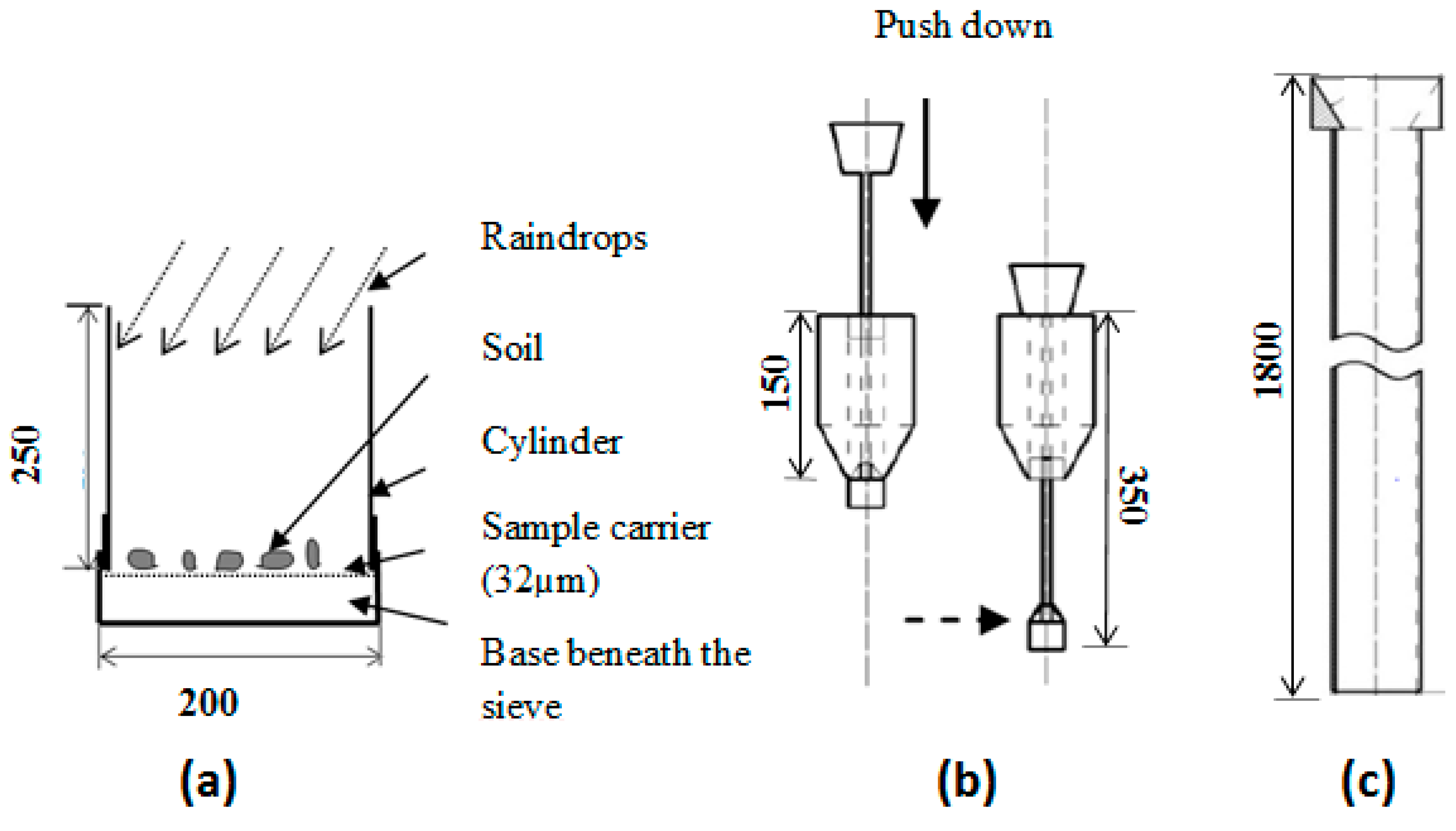
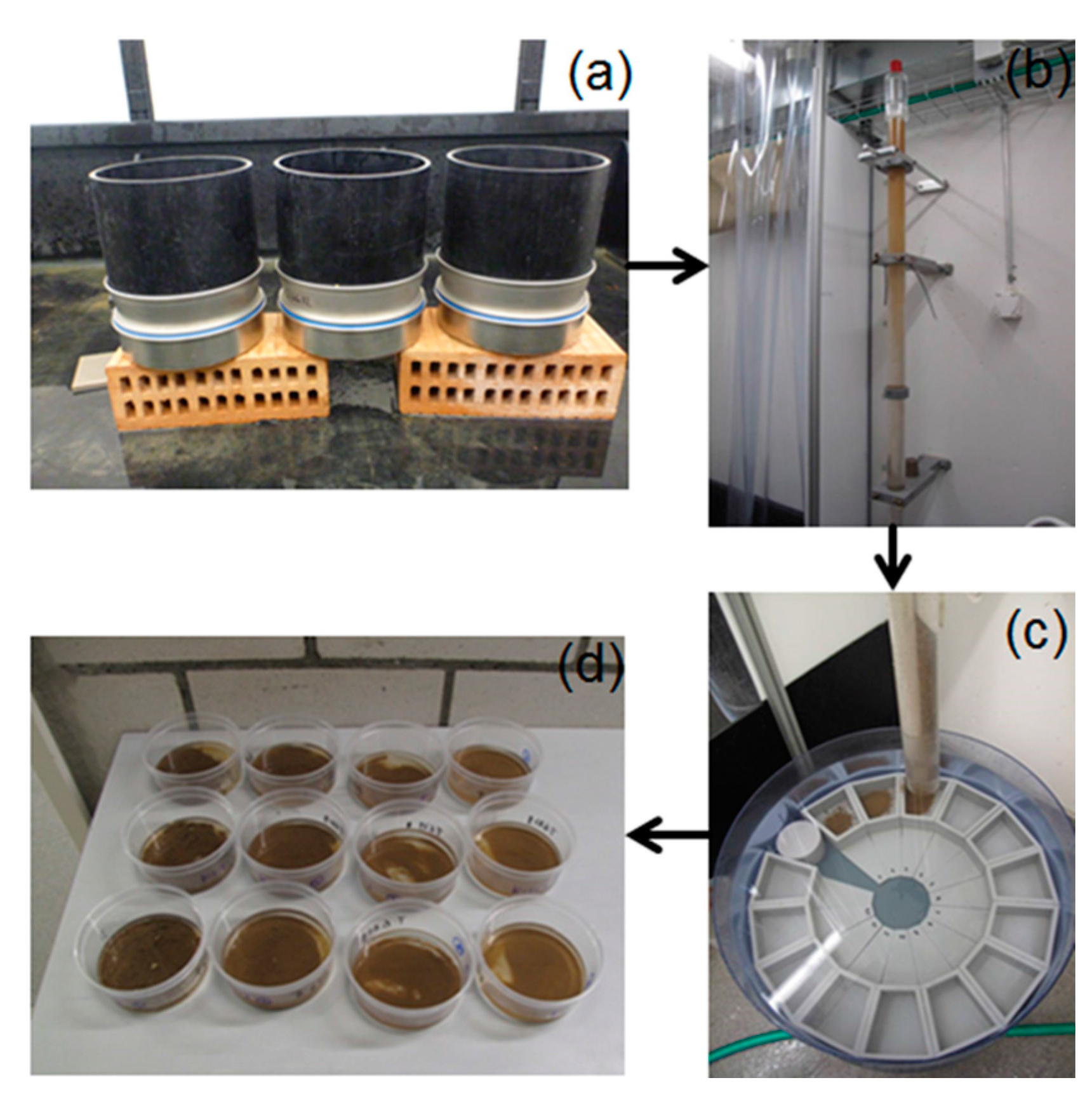
2.2. Raindrop Aggregate Destruction Test (RADT)
- (1)
- A sample carrier consisting of a 32-µm sieve to hold the dry soil samples prior to raindrop impact, and to collect aggregates surviving raindrop impact. The sieve can be uniformly covered by 25 g of soil, generating sufficient material to perform a settling tube fractionation. The sieve also allows a slow, but free drainage of water. This design ensures that a certain degree of ponding occurs, which resembles natural raindrop-impacted flow conditions [30], and prevents accumulation of surface water from forming a film, which attenuates the effect of raindrop kinetic energy on the soil surface [58,59].
- (2)
- A base beneath the sample carrier to collect fine particles and redundant water passing through the sieve.
- (3)
- A 25 cm tall cylinder embracing the sample carrier (the cylinder is 20 cm taller than the surface of the carrier). With this design, splashed particles can be caught on the sidewalls of the RADT and washed back to the base by rainwater, so that the RADT can capture all the sediment generated by raindrop impact.
2.3. Settling Tube (ST)
- (1)
- The actual settling tube with a water column through which soil fractions settle.
- (2)
- An injection device to introduce soil into the tube.
- (3)
- A turntable to collect separated sample fractions.
- (4)
- A control panel to control the movement of the turntable.
| Possible Fate (Starr et al. [34]) | Settling Velocity (mm·s−1) | EQS | Proportion of Mineral Grain/Proportion of Aggregate | |||
|---|---|---|---|---|---|---|
| (µm) | Möhlin | Weinan | Exeter | Eifel | ||
| Deposited across landscapes | 90–180 | 500–1000 | 0.11 | - | 0.15 | 0.10 |
| 45–90 | 250–500 | 0.15 | - | 0.29 | 0.23 | |
| 15–45 | 125–250 | 0.16 | 0.36 | 0.13 | 0.11 | |
| 3–15 | 62–125 | 0.60 | 0.69 | 0.29 | 0.37 | |
| Possible transfer to aquatic systems | 1–3 | 32–62 | 0.80 | 1.00 | 0.71 | 0.63 |
| <1 | <32 | 2.11 | 1.80 | 3.85 | 2.67 | |
2.4. Mean Weight Settling Velocity (MWSV)
3. The Application of the RADT-ST Method
3.1. Soil Samples and Preparations
| Sampling Date | Sampling Country | Coordinates | |
|---|---|---|---|
| Möhlin | March 2012 | Switzerland | 47°33′N, 7°50′E |
| Weinan | February 2013 | China | 34°30′N, 109°30′E |
| Exeter | April 2013 | UK | 50°44′N, 3°31′W |
| Eifel | April 2013 | Germany | 50°02′N, 6°43′E |
| Clay (%) | Silt (%) | Sand (%) | SOC mg·g−1 | Water Stable Aggregate (WSA) >250 µm (%) | MWSV of Mineral Grain (mm·s−1) | |
|---|---|---|---|---|---|---|
| Möhlin | 6.12 (0.06) | 78.12 (0.13) | 15.76 (0.19) | 9.60 (0.10) | 67.13 (0.61) | 3.92 (0.49) |
| Weinan | 6.78 (0.26) | 72.52 (0.34) | 20.70 (0.09) | 4.31 (0.03) | 48.00 (3.66) | 3.13 (0.02) |
| Exeter | 10.53 (0.47) | 75.37 (1.70) | 14.10 (1.23) | 24.30 (0.04) | 43.73 (1.82) | 8.67 (1.26) |
| Eifel | 9.04 (0.70) | 79.15 (0.96) | 11.81 (0.26) | 19.40 (0.07) | 54.42 (0.82) | 4.71 (0.42) |
3.2. RADT-ST Test Procedure and Rainfall Simulation
3.3. Mineral Grain Size Distribution
4. Results and Discussion
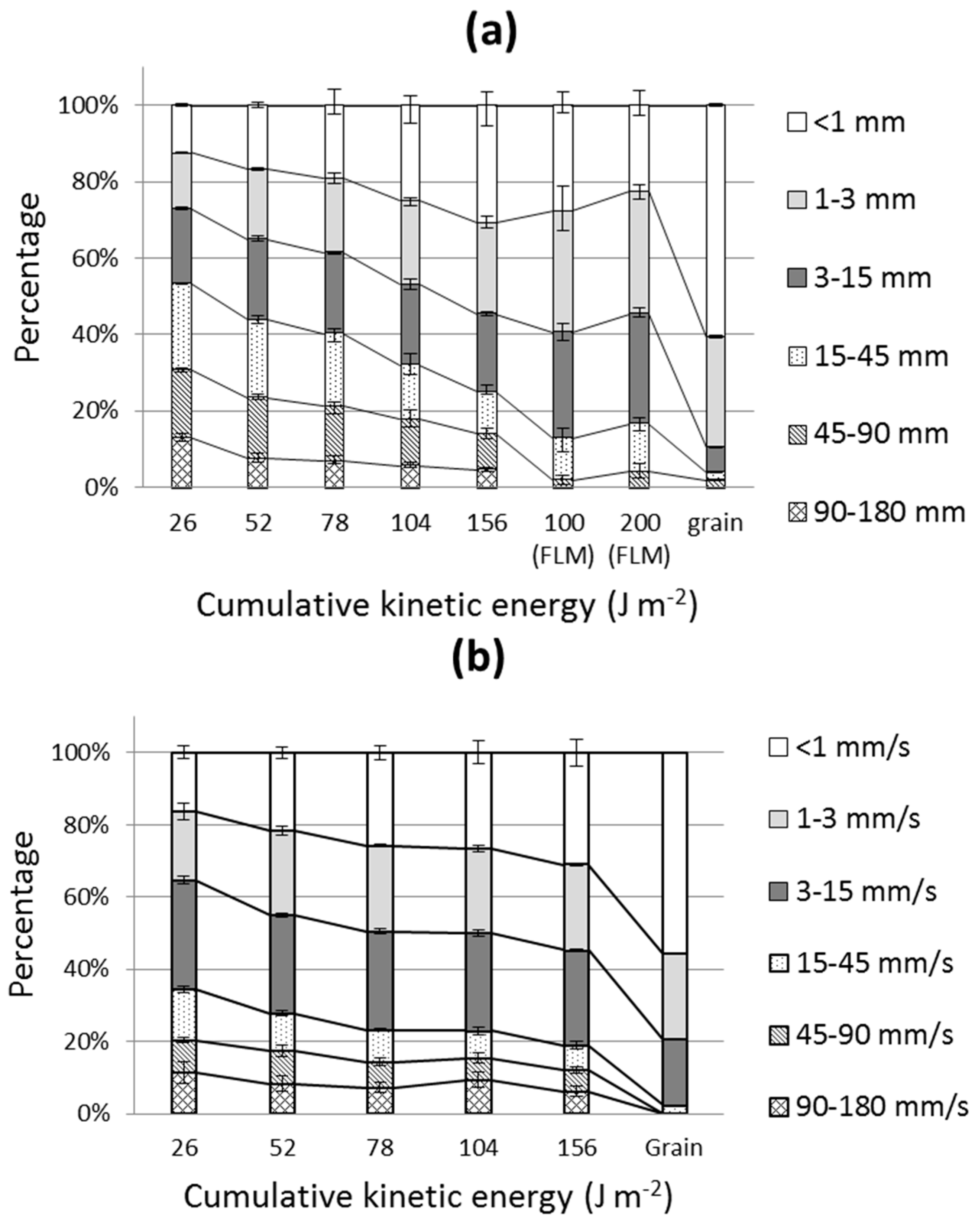
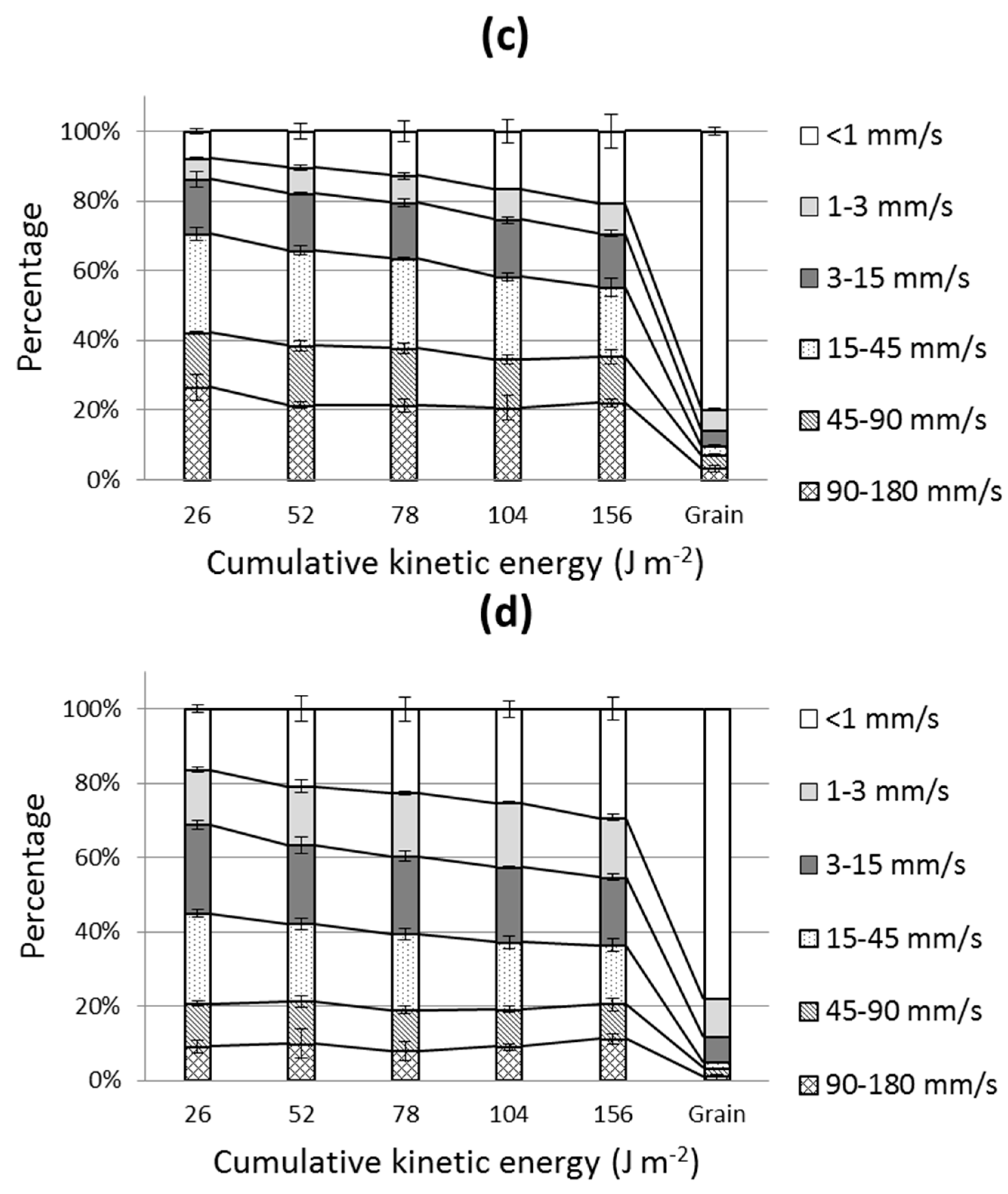
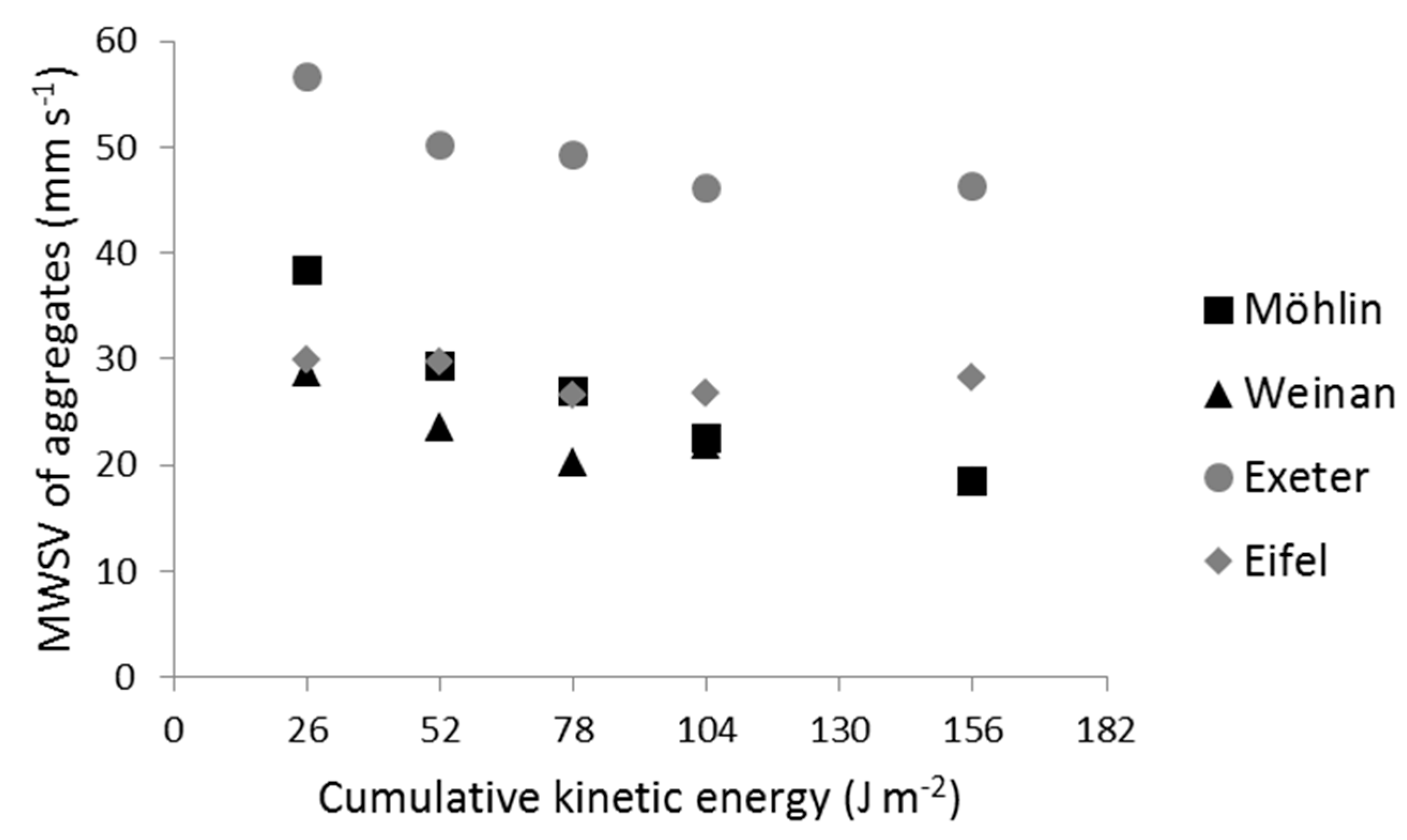
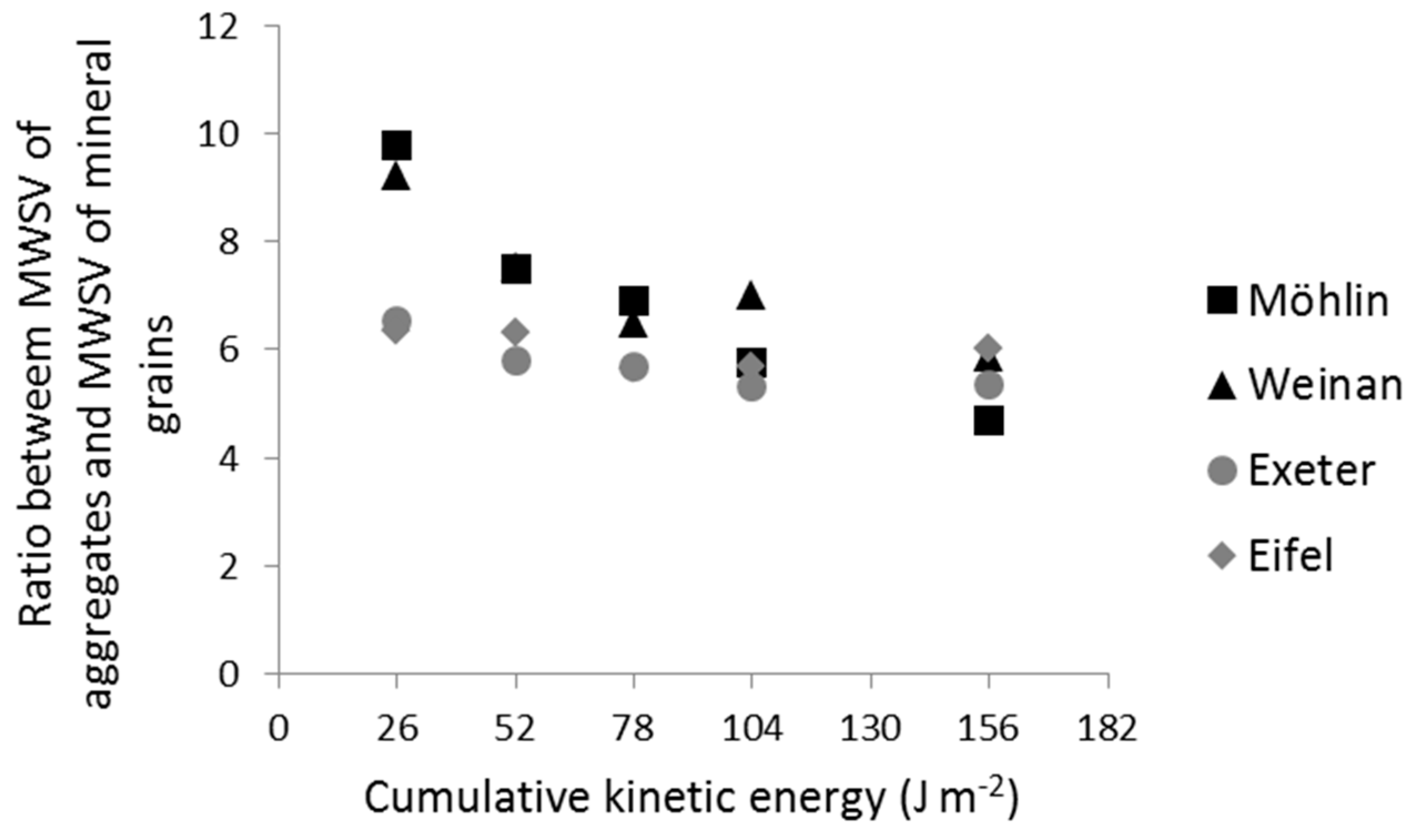
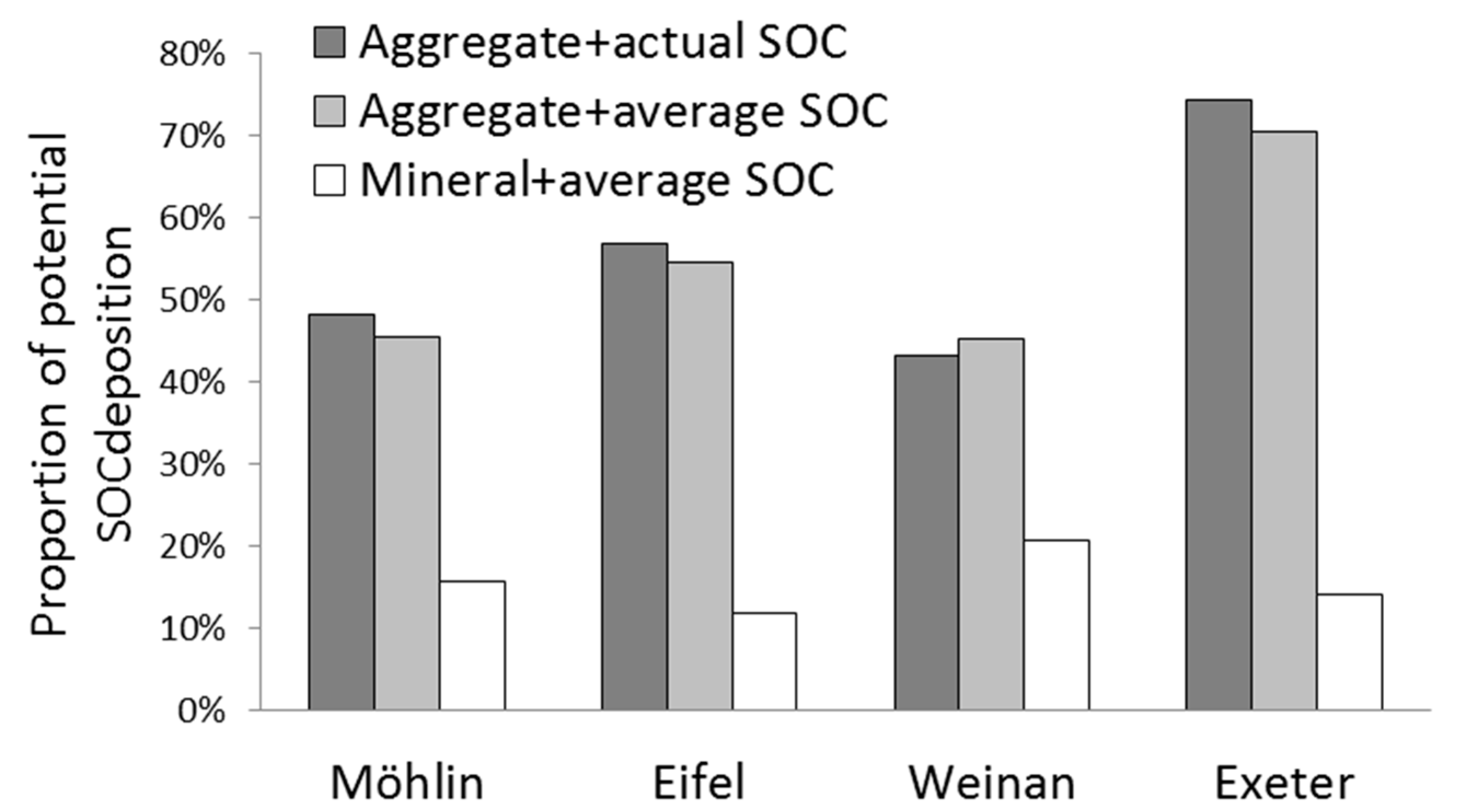
5. Conclusions
Acknowledgments
Author Contributions
Conflicts of Interest
References
- Pimentel, D.; Harver, C.; Resosudarmo, P.; Sinclair, K.; Kurz, D.; McNair, M.; Crist, S.; Shpritz, L.; Fitton, L.; Saffouri, R.; et al. Environmental and economic costs of soil erosion and conservation benefits. Science 1995, 267, 1117–1123. [Google Scholar] [CrossRef] [PubMed]
- Cerdà, A.; Giménez-Morera, A.; Bodí, M.B. Soil and water losses from new citrus orchards growing on sloped soils in the western Mediterranean basin. Earth Surf. Process. Landf. 2009, 34, 1822–1830. [Google Scholar] [CrossRef]
- Lieskovský, J.; Kenderessy, P. Modelling the effect of vegetation cover and different tillage practi-ces on soil erosion in vineyards: A case study en Vráble (Slovakia) using Watem/Sedem. Land Degrad. Dev. 2014, 25, 288–296. [Google Scholar] [CrossRef]
- Zhao, G.; Mu, X.; Wen, Z.; Wang, F.; Gao, P. Soil erosion, conservation, and Eco-environment changes in the Loess Plateau of China. Land Degrad. Dev. 2013, 24, 499–510. [Google Scholar] [CrossRef]
- Cerdà, A.; Flanagan, D.C.; le Bissonnais, Y.; Boardman, J. Soil erosion and agriculture. Soil Tillage Res. 2009, 106, 107–108. [Google Scholar] [CrossRef]
- Colazo, J.C.; Buschiazzo, D. The impact of agriculture on soil texture due to wind erosion. Land Degrad. Dev. 2015, 26, 62–70. [Google Scholar] [CrossRef]
- Lal, R. Soil erosion and the global carbon budget. Environ. Int. 2003, 29, 437–450. [Google Scholar] [CrossRef]
- Ritter, W.F.; Shirmohammadi, A. Agricultural Nonpoint Source Pollution, Watershed Management and Hydrology; Lewis Publishers: New York, NY, USA, 2001; p. 342. [Google Scholar]
- Belsky, J.A.; Matzke, A.; Uselman, S. Survey of livestock influences on stream and riparian ecosystems in the western United States. J. Soil Water Conserv. 1999, 54, 419–431. [Google Scholar]
- Greenwood, P.; Kuhn, N.J. Does the invasive plant, Impatiens glandulifera, promote soil erosion along the riparian zone? An investigation on a small watercourse in northwest Switzerland. J. Soils Sediments 2014, 14, 637–650. [Google Scholar] [CrossRef]
- Jordan, C.; McGuckin, S.O.; Smith, R.V. Increased predicted losses of phosphorus to surface waters from soils with high Olsen-P concentrations. Soil Use Manag. 2000, 16, 27–35. [Google Scholar] [CrossRef]
- Quinton, J.N.; Catt, J.A.; Hess, T.M. The selective removal of phosphorus from soil: Is event size important? J. Environ. Qual. 2001, 30, 538–545. [Google Scholar] [CrossRef] [PubMed]
- Kuhn, N.J.; Armstrong, E.K.; Ling, A.C.; Connolly, K.L.; Heckrath, G. Interrill erosion of carbon and phosphorus from conventionally and organically farmed Devon silt soils. CATENA 2012, 91, 94–103. [Google Scholar] [CrossRef]
- Baker, L.A. Introduction to nonpoint source pollution in the United States and prospects for wetland use. Ecol. Eng. 1992, 1, 1–26. [Google Scholar] [CrossRef]
- Lal, R. Soil carbon sequestration impacts on global climate change and food security. Science 2004, 304, 1623–1627. [Google Scholar] [CrossRef] [PubMed]
- Van Oost, K.; Quine, T.A.; Govers, G.; de Gryze, S.; Six, J.; Harden, J.W.; Ritchie, J.C.; McCarty, G.W.; Heckrath, G.; Kosmas, C.; et al. The impact of agricultural soil erosion on the global carbon cycle. Science 2007, 318, 626–629. [Google Scholar] [CrossRef] [PubMed]
- Berhe, A.A.; Harte, J.; Harden, J.W.; Torn, M.S. The significance of the erosion-induced terrestrial carbon sink. BioScience 2007, 57, 337–346. [Google Scholar] [CrossRef]
- Kuhn, N.J.; Hoffmann, T.; Schwanghart, W.; Dotterweich, M. Agricultural soil erosion and global carbon cycle: Controversy over? Earth Surf. Process. Landf. 2009, 34, 1033–1038. [Google Scholar] [CrossRef]
- Quinton, J.N.; Govers, G.; van Oost, K.; Bardgett, R.D. The impact of agricultural soil erosion on biogeochemical cycling. Nat. Geosci. 2010, 3, 311–314. [Google Scholar] [CrossRef] [Green Version]
- Kirkels, F.M.S.A.; Cammeraat, L.H.; Kuhn, N.J. The fate of soil organic carbon upon erosion, transport and deposition in agricultural landscapes—A review of different concepts. Geomorphology 2014, 226, 94–105. [Google Scholar] [CrossRef]
- Fiener, P.; Auerswald, K.; van Oost, K. Spatio-temporal patterns in land use and management affecting stromflow response of agricultural catchments—A review. Earth Sci. Rev. 2011, 106, 92–104. [Google Scholar] [CrossRef]
- Kuhn, N.J. Assessing Lateral Organic Carbon Movement in Small Agricultural Catchments. Available online: http://www.wsl.ch/dienstleistungen/publikationen/pdf/12491.pdf (accessed on 15 October 2015).
- Lal, R.; Pimentel, D. Letter on “Soil Erosion: A carbon sink or source?”. Science 2008, 319, 1040–1041. [Google Scholar] [CrossRef] [PubMed]
- Kinnell, P.I.A. Particle travel distances and bed and sediment compositions associated with rain-Impacted flows. Earth Surf. Process. Landf. 2001, 26, 749–758. [Google Scholar] [CrossRef]
- Kuhn, N.J.; Armstrong, E.K. Erosion of organic matter from sandy soils: Solving the mass balance. CATENA 2012, 98, 87–95. [Google Scholar] [CrossRef]
- Fiener, G.; Govers, G.; van Oost, K. Evaluation of a dynamic multi-class sediment transport model in a catchment under soil-conservation agriculture. Earth Surf. Process. Landf. 2008, 33, 1639–1660. [Google Scholar]
- Loch, R.J. Settling velocity—A new approach to assessing soil and sediment properties. Comput. Electron. Agric. 2001, 31, 305–316. [Google Scholar] [CrossRef]
- Van Oost, K.; Govers, G.; Quine, T.A.; Heckrath, G.; Olesen, J.E.; de Gryze, S.; Merckx, R. Landscape-scale modeling of carbon cycling under the impact of soil redistribution: The role of tillage erosion. Glob. Biogeochem. Cycles 2005, 19, 1733–1739. [Google Scholar] [CrossRef]
- Van Oost, K.; Beuselinck, L.; Hairsine, P.B.; Govers, G. Spatial evaluation of a multi-class sediment transport and deposition model. Earth Surf. Process. Landf. 2004, 29, 1027–1044. [Google Scholar] [CrossRef]
- Hu, Y.; Kuhn, N.J. Aggregates reduce transport distance of soil organic carbon: Are our balances correct? Biogeosciences 2014, 11, 6209–6219. [Google Scholar] [CrossRef]
- Hairsine, P.B.; Rose, C.W. Rainfall detachment and deposition: Sediment transport in the absence of flow-driven processes. Soil Sci. Soc. Am. J. 1991, 55, 320–324. [Google Scholar] [CrossRef]
- Hairsine, P.B.; Rose, C.W. Modelling water erosion due to overland flow using physical principles: I. Uniform flow. Water Resour. Res. 1992, 28, 237–243. [Google Scholar] [CrossRef]
- Hairsine, P.B.; Rose, C.W. Modelling water erosion due to overland flow using physical principles: II. Rill flow. Water Resour. Res. 1992, 28, 245–250. [Google Scholar] [CrossRef]
- Starr, G.C.; Lal, R.; Malone, R.; Hothem, D.; Owens, L.; Kimble, J. Modeling soil carbon transported by water erosion process. Land Degrad. Dev. 2000, 11, 83–91. [Google Scholar] [CrossRef]
- Wang, Z.; Govers, G.; Steegen, A.; Clymans, W.; van den Putte, A.; Langhans, C.; Merckx, R.; van Oost, K. Catchment-scale carbon redistribution and delivery by water erosion in an intensively cultivated area. Geomorphology 2010, 124, 65–74. [Google Scholar] [CrossRef]
- Nadeu, E.; de Vente, J.; Martínez-Mena, M.; Boix-Fayos, C. Exploring particle size distribution and organic carbon pools mobilized by different erosion processes at the catchment scale. J. Soils Sediments 2011, 11, 667–678. [Google Scholar]
- Hairsine, P.B.; McTainsh, G.H. The Griffith Tube: A Simple Settling Tube for the Measurement of Settling Velocity of Soil Aggregates; AES working paper 3/86; Griffith University: Brisbane, Australia, 1986. [Google Scholar]
- Smith, R.E.; Quinton, J.; Goodrich, D.C.; Nearing, M. Soil-erosion models: Where do we really stand? Earth Surf. Process. Landf. 2010, 35, 1344–1348. [Google Scholar] [CrossRef]
- Proffitt, A.P.B.; Rose, C.W.; Lovell, C.J. Settling velocity characteristics of sediment detached from a soil surface by raindrop impact. Catena 1993, 20, 27–40. [Google Scholar] [CrossRef]
- Proffitt, A.P.B.; Rose, C.W. Soil erosion processes II. Settling velocity characteristics of eroded sediment. Aust. J. Soil Res. 1991, 29, 685–695. [Google Scholar] [CrossRef]
- Lovell, C.J.; Rose, C.W. Wake capture effects observed in a comparison of methods to measure particle settling velocity beyond Stokes’ range. J. Sediment. Petrol. 1991, 61, 575–582. [Google Scholar] [CrossRef]
- Lovell, C.J.; Rose, C.W. The effects of sediment concentration and tube-diameter on particle settling velocity measured beyond Stokes’ range: Experiment and theory. J. Sediment. Petrol. 1991, 61, 583–589. [Google Scholar] [CrossRef]
- Lu, H.; Moran, C.J.; Prosser, I.P. Modelling sediment delivery ratio over the Murray Darling Basin. Environ. Model. Softw. 2006, 21, 1297–1308. [Google Scholar] [CrossRef]
- Pieri, L.; Bittelli, M.; Wu, J.Q.; Dun, S.; Flanagan, D.C.; Pisa, P.R.; Ventura, F.; Salvatorelli, F. Using the Water Erosion Prediction Project (WEPP) model to simulate field-observed runoff and erosion in the Apennines Mountain Range, Italy. J. Hydrol. 2007, 336, 84–97. [Google Scholar] [CrossRef]
- Walling, D.E. Erosion and sediment yield research—Some recent perspectives. J. Hydrol. 1988, 100, 113–141. [Google Scholar] [CrossRef]
- Dietrich, W.E. Settling velocity of natural particles. Water Resour. Res. 1982, 18, 1615–1626. [Google Scholar] [CrossRef]
- Angima, S.D.; Stott, D.E.; O’Neill, M.K.; Ong, C.K.; Weesies, G.A. Soil erosion prediction using RUSLE for central Kenyan highland conditions. Agric. Ecosyst. Environ. 2003, 97, 295–308. [Google Scholar] [CrossRef]
- Le Bissonnais, Y. Aggregate stability and assessment of soil crustability and erodibility: I. Theory and methodology. Eur. J. Soil Sci. 1996, 47, 425–437. [Google Scholar] [CrossRef]
- Levy, G.J.; Warrington, D.N.; Bhardwaj, A.K.; Mamedov, A.I. Changes in eroded material and runoff as affected by rain depth and aggregate slaking in three semiarid region soils. Geophys. Res. Abstr. 2007, 9, 05380. [Google Scholar]
- Renard, K.G.; Foster, G.R.; Weesies, G.A.; Porter, J.P. Rusle: Revised universal soil loss equation. J. Soil Water Conserv. 1991, 46, 30–33. [Google Scholar]
- Van Oost, K.; Verstraeten, G.; Doetterl, S.; Notebaert, B.; Wiaux, F.; Broothaerts, N.; Six, J. Legacy of human-induced C erosion and burial on soil-atmosphere C exchange. Proc. Natl. Acad. Sci. USA 2012, 109, 19492–19497. [Google Scholar] [CrossRef] [PubMed]
- Ries, J.B.; Iserloh, T.; Seeger, M.; Gabriels, D. Rainfall simulations—Constraints, needs and challenges for a future use in soil erosion research. Z. Geomorphol. Suppl. 2013, 57, 1–10. [Google Scholar] [CrossRef]
- Iserloh, T.; Ries, J.B.; Arnaez, J.; Boix Fayos, C.; Butzen, V.; Cerdá, A.; Echeverría, M.; Fernández-Gálvez, J.; Fister, W.; Gómez, J.A. European small portable rainfall simulators: A comparison of rainfall characteristics. CATENA 2013, 110, 100–112. [Google Scholar] [CrossRef] [Green Version]
- Kuhn, N.J.; Bryan, R.B.; Navar, J. Seal formation and interrill erosion on a smectite-rich Kastanozem from NE-Mexico. CATENA 2003, 52, 149–169. [Google Scholar] [CrossRef]
- Kuhn, N.J.; Bryan, R.B. Drying, soil surface condition and interrill erosion on two Ontario soils. Catena 2004, 57, 113–133. [Google Scholar] [CrossRef]
- Kuhn, N.J. Erodibility of soil and organic matter: Independence of organic matter resistance to interrill erosion. Earth Surf. Process. Landf. 2007, 35, 1344–1348. [Google Scholar] [CrossRef]
- Hu, Y.; Fister, W.; Rüegg, H.R.; Kinnell, P.I.A.; Kuhn, N.J. The Use of Equivalent Quartz Size and Settling Tube Apparatus to Fractionate Soil Aggregates by Settling Velocity. Available online: http://www.geomorphology.org.uk/sites/default/files/geom_tech_chapters/1.1.1_SettlingTube.pdf (accessed on 15 October 2015).
- Kinnell, P.I.A. Sediment transport by medium to large drops impacting flows at subterminal velocity. Soil Sci. Soc. Am. J. 2005, 69, 902–905. [Google Scholar] [CrossRef]
- Kinnell, P.I.A. Raindrop-impact-induced erosion processes and prediction: A review. Hydrol. Process. 2005, 19, 2815–2844. [Google Scholar] [CrossRef]
- Gibbs, R.J.; Matthews, M.D.; Link, D.A. The relationship between sphere size and settling velocity. J. Sediment. Petrol. 1971, 41, 7–18. [Google Scholar]
- Pert, M.R.; Walling, D.E. Particle size characteristics of fluvial suspended sediment. In Recent Developments in the Explanation and Prediction of Erosion and Sediment Yield; International Association of Hydrological Sciences (IAHS): Exeter, UK, 1982; pp. 397–407. [Google Scholar]
- Polyakov, V.O.; Lal, R. Soil organic matter and CO2 emission as affected by water erosion on field runoff plots. Geoderma 2008, 143, 216–222. [Google Scholar] [CrossRef]
- Iserloh, T.; Fister, W.; Seeger, M.; Willger, H.; Ries, J.B. A small portable rainfall simulator for reproducible experiments on soil erosion. Soil Tillage Res. 2012, 124, 131–137. [Google Scholar] [CrossRef]
- MeteoSwiss. Monthly Total Precipitation during April, May, and June at Station Arisdorf (47°30′N, 7°46′E) Near Möhlin from 1985 to 2012; MeteoSwiss, Federal Office of Meteorology and Climatology: Zürich, Switzerland, 2013. [Google Scholar]
- Wan, L.; Zhang, X.P.; Ma, Q.; Zhang, J.J.; Ma, T.Y.; Sun, Y.P. Spatiotemporal characteristics of precipitation and extreme events on the Loess Plateau of China between 1957 and 2009. Hydrol. Process. 2014, 28, 4971–4983. [Google Scholar] [CrossRef]
- Torri, D.; Regüés, D.; Pellegrini, S.; Bazzoffi, P. Within-storm soil surface dynamics and erosive effects of rainstorms. Catena 1999, 38, 131–150. [Google Scholar] [CrossRef]
- Flanagan, D.C.; Livingston, S.J. (Eds.) Water Erosion Prediction Project (WEPP) Version 95.7, User Summary. In WEPP User Summary; Report No. 11; NSERL: West Lafayette, IN, USA, 1995.
© 2015 by the authors; licensee MDPI, Basel, Switzerland. This article is an open access article distributed under the terms and conditions of the Creative Commons Attribution license (http://creativecommons.org/licenses/by/4.0/).
Share and Cite
Xiao, L.; Hu, Y.; Greenwood, P.; Kuhn, N.J. A Combined Raindrop Aggregate Destruction Test-Settling Tube (RADT-ST) Approach to Identify the Settling Velocity of Sediment. Hydrology 2015, 2, 176-192. https://doi.org/10.3390/hydrology2040176
Xiao L, Hu Y, Greenwood P, Kuhn NJ. A Combined Raindrop Aggregate Destruction Test-Settling Tube (RADT-ST) Approach to Identify the Settling Velocity of Sediment. Hydrology. 2015; 2(4):176-192. https://doi.org/10.3390/hydrology2040176
Chicago/Turabian StyleXiao, Liangang, Yaxian Hu, Philip Greenwood, and Nikolaus J. Kuhn. 2015. "A Combined Raindrop Aggregate Destruction Test-Settling Tube (RADT-ST) Approach to Identify the Settling Velocity of Sediment" Hydrology 2, no. 4: 176-192. https://doi.org/10.3390/hydrology2040176





